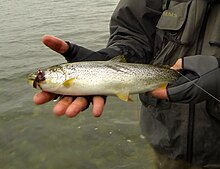Coastal cutthroat trout
| Coastal cutthroat trout | |
|---|---|

| |
| Scientific classification | |
| Domain: | Eukaryota |
| Kingdom: | Animalia |
| Phylum: | Chordata |
| Class: | Actinopterygii |
| Order: | Salmoniformes |
| Family: | Salmonidae |
| Genus: | Oncorhynchus |
| Species: | |
| Subspecies: | O. c. clarkii
|
| Trinomial name | |
| Oncorhynchus clarkii clarkii (Richardson, 1836)[2]
| |
The coastal cutthroat trout (Oncorhynchus clarkii clarkii), also known as the sea-run cutthroat trout, blue-back trout or harvest trout, is one of the several subspecies of
Adults migrate from the ocean to spawn in fresh water. Juveniles migrate to the sea where they feed and become sexually mature before returning to fresh water to overwinter and spawn. Unlike
Taxonomy
Cutthroat trout were given the name Salmo clarkii in honor of
Description
Freshwater forms of the coastal cutthroat trout are generally dark green to greenish-blue on back, olive-green on upper flank, silvery on lower flank and belly. They display more numerous flank spots below lateral line, irregular spots on dorsal, adipose and caudal fins and the anal, pectoral and pelvic fin bases. The gill covers are pinkish. Sea-run forms while in salt water and shortly after returning to fresh water are silvery with a bluish back, yellowish lower flanks and fins, and display sparse spots. Cutthroats usually display distinctive red, pink, or orange linear marks along the undersides of their mandibles in the lower folds of the gill plates. These markings are responsible for the common name "cutthroat" given to the trout by outdoor writer Charles Hallock in an 1884 article in The American Angler.,[6] although the red slashes are not unique to the cutthroat trout and some coastal rainbow trout and redband trout also display throat slashes. The sea-run forms of coastal cutthroat average 2 to 5 lb (0.9 to 2.3 kg), while stream-resident forms attain much smaller sizes 0.4 to 3.2 oz (11 to 91 g).
Lifecycle
Coastal cutthroat trout usually inhabit and spawn in small to moderately large, clear, well-
Cutthroat trout naturally interbreed with the closely related rainbow trout, producing fertile hybrids commonly called "cutbows" although this is a much rarer occurrence with the coastal cutthroat trout because of reproductive isolation as the coastal cutthroat trout is the only cutthroat subspecies to coevolve through its entire range with the coastal rainbow trout (O. mykiss irideus). As this hybrid generally bears similar coloration and overall appearance to the cutthroat, retaining the characteristic orange-red slash, these hybrids often pose a taxonomic difficulty.[7]
Range and habitat
The native range of the coastal cutthroat trout extends south from the southern coastline of the
Coastal cutthroat trout use a large variety of habitat types, including lower and upper reaches of both large and small river systems, estuaries, sloughs, ponds, lakes, and near shore ocean waters. They spend more time in fresh water environments than other anadromous Pacific salmonids. In fresh water they prefer deeper pool habitat and cover, such as that formed by woody debris. The semi-anadromous forms of coastal cutthroat trout do not overwinter in saltwater and rarely make extended migrations across large bodies of water. Migrations in the marine environment are usually within 6 miles (9.7 km) of land. Semi-anadromous coastal cutthroat typically spend two to five years rearing in fresh water before making their initial migration into saltwater. Generally, semi-anadromous coastal cutthroat trout spend short periods offshore during summer months and return to estuaries and fresh water by fall or winter.[10]
Conservation status
The coastal cutthroat is a secure subspecies of the cutthroat trout. Although there has been a general population decline of the sea-run form throughout its native range since the 19th century, none of the populations in the United States or British Columbia are considered threatened or endangered. The
Stream resident, fluvial and lake forms are secure within their native range and supplemented by stocking of hatchery raised fish in Washington and Oregon.
Notes

- ^ NatureServe (4 August 2023). "Oncorhynchus clarkii clarkii". NatureServe Network Biodiversity Location Data accessed through NatureServe Explorer. Arlington, Virginia: NatureServe. Retrieved 20 August 2023.
- ^ a b c Richardson, John; Swainson, William; Kirby, William (1836), Fauna boreali-americana, or, The zoology of the northern parts of British America: containing descriptions of the objects of natural history collected on the late northern land expedition, under command of Captain Sir John Franklin, R.N., London: J. Murray, pp. 225–226
- ^ ISBN 0-7432-2220-2.
- hdl:2027.42/140998.
- ISBN 0-7432-2220-2.
- ISBN 978-0-520-25458-9.
- ISBN 978-0-300-14087-3.
- ^ ISBN 0-7432-2220-2.
- ISBN 978-0-520-25458-9.
- ^ "Species Fact Sheet Coastal Cutthroat Trout Oncorhynchus clarki" (PDF). U.S. Fish and Wildlife Service. Retrieved 2014-01-09.
- ^ "Federal Register/Vol. 64, No. 64/Monday, April 5, 1999/Proposed Rules" (PDF). U.S. Fish and Wildlife Service. pp. 16397–16413. Retrieved 2014-01-09.
- ^ a b Connolly, Patrick J.; Williams, Thomas H.; Gresswell, Robert E., eds. (2008). "The 2005 Coastal Cutthroat Trout Symposium Status, Management, Biology, and Conservation" (PDF). Portland, Oregon: Oregon Chapter of the American Fisheries Society.
Further reading
- Oliver B. Cope (1958). "Annotated Bibliography on the Cutthroat Trout-Fishery Bulletin 140" (PDF). U.S. Fish and Wildlife Service. Retrieved 2014-01-07.
- Johnson, Les (1976). Sea-run Cutthroat Trout. Portland, OR: Frank Amato Publishers. ISBN 978-0-936608-02-0.
- Johnson, Les (2004). Fly-Fishing Coastal Cutthroat Trout: Flies, Techniques, Conservation. Portland, OR: Frank Amato Publishers. ISBN 978-1-57188-334-6.
- Trotter, Patrick C. (2008). Cutthroat: Native Trout of the West (2nd ed.). Berkeley, CA: University of California Press. ISBN 978-0-520-25458-9.
- Suckley, G. (Spring 1980). Raymond, Steve (ed.). "Sea-Run Cutthroats" (PDF). The American Fly Fisher. 7 (2). American Museum of Fly Fishing: 30–31. Archived from the original (PDF) on 2014-11-29. Retrieved 2014-11-21.






